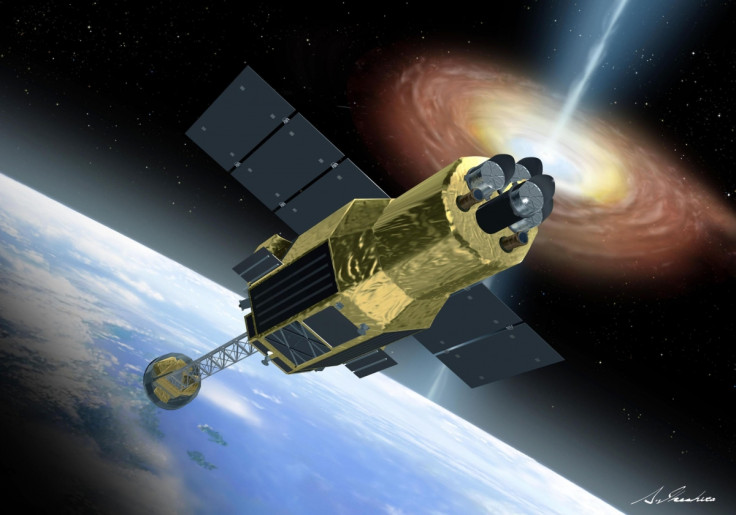Japan's Hitomi satellite might still be alive as it's emitting signals despite breaking into pieces

The Japan Aerospace Exploration Agency (JAXA) says it is still receiving signals from the its black hole-hunting satellite Hitomi, even though it is likely that the $273m (£191m) observatory has broken into multiple pieces.
Hitomi, which is a state-of-the-art x-ray observatory, was developed in conjunction with Nasa, the European Space Agency (ESA) and the Canadian Space Agency (CSA), with the intention of having it observe and analyse some of the greats secrets of the universe, such as black holes and exploding stars.
Hitomi, also known as ASTRO-H, was launched into space on 17 February, but JAXA lost contact with the satellite 4.40pm GMT (00.40am JST, 09.40am CST) on 26 March. Then on 27 March, the US Joint Space Operations Center (JSpOC), which tracks and monitors all space debris near Earth tweeted that five pieces of debris were seen floating in the vicinity of Hitomi around the same time that it lost communication with Earth.
JSpOC ID’d 2 breakups: SL-12 R/B(33472) @~0145z, 27Mar–21 pieces. ASTRO H(41337) @~0820z, 26Mar–5 pieces. Events not related. @SpaceTrackOrg
— JSpOC (@JointSpaceOps) March 27, 2016
Then on 28 March, JSpOC confirmed that its analysis of the incident showed that the Hitomi satellite definitely did break into multiple pieces, which means that the satellite was possibly hit by some sort of space debris that caused it break into pieces.
Update: Analysis shows ASTRO H breakup occurred 26Mar @ 0142z
— JSpOC (@JointSpaceOps) March 28, 2016
+/- 11mins. JSpOC confirmed breakup @ 0820z. @JAXA_en @SpaceTrackOrg
Correctly, JSpOC reported in the twitter that Hitomi separated into
— JAXA Web (@JAXA_en) March 28, 2016
multiple pieces BEFORE March 26 0820 (UT).
RT https://t.co/CXaReTxg5E
Now that's pretty bad news, and JAXA has since confirmed JSpOC's report, but the Japanese space agency hasn't given up on finding Hitomi, and in fact posted an update on 29 March at 2pm GMT (10pm JST, 7am CST), stating that it received signals from the satellite on two separate occasions.
"The Japan Aerospace Exploration Agency (JAXA) has been trying to communicate with the X-ray Astronomy Satellite "Hitomi" (ASTRO-H), using ground stations both in Japan and overseas. By utilising two opportunities of communicating with Hitomi, JAXA received signals from the satellite: the first time was at about 10pm on 28 (March) at the Uchinoura Ground Station, and the second one was at around 0.30am on 29 (March) at the Santiago Tracking Station in Chile," JASA wrote in its update.
"JAXA has not been able to figure out the state of its health, as the time frames for receiving the signals were very short."
So in fact, Hitomi might not have suffered extensive damage after all, a belief echoed by Dr Jonathan McDowell, an astrophysicist at the Harvard-Smithsonian Center for Astrophysics who is also the author of Jonathan's Space Report, a bi-monthly newsletter that documents satellite launches.
"'Debris' doesn't mean Hitomi's in little pieces. It means little pieces have come off it. Satellite might be basically intact, we don't know," McDowell wrote in a post that was retweeted by JSpOC.
"Debris" doesn't mean Hitomi's in little pieces. It means little pieces
— Jonathan McDowell (@planet4589) March 27, 2016
have come off it. Satellite might be basically intact,we don't know
JAXA also confirmed that telescopes at the Bisei Space Guard Center (BSGC) owned by the Japan Space Forum detected two objects around the satellite's original orbit, and that a radar located at the Kamisaibara Space Guard Center (KSGC) identified one of the objects. The space agency says it is continuing to investigate the connection between JSpOC's information and the communication anomaly.
For now, we still very little about what's happened to the Hitomi satellite, but it would be great if $273m hadn't gone completely down the drain.
© Copyright IBTimes 2025. All rights reserved.






















